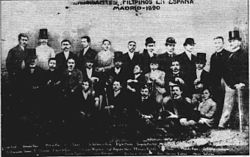Dagohoy Lodge No. 84
In the Beginning...
The history of Philippine Masonry may be likened to the history of the first Grand Lodge. On the Feast of St. John the Baptist in 1717, four of the pre-existing Masonic lodges in Great Britain organized what became the first Grand Lodge of the world. On December 19, 1912, three lodges that were chartered under the Constitution of the Grand Lodge of California finally succeeded in establishing the Grand Lodge of Free and Accepted Masons of the Philippine Islands, the forerunner of what is now officially known as the Most Worshipful Grand Lodge of Free and Accepted Masons of the Philippines.
Masonry existed in England long before the creation of the first Grand Lodge, so was Philippine Masonry already alive even before the formation of the Grand Lodge of the Philippine Islands. In 1856, for example, Primera Luz Filipina, the first Masonic Lodge in the Philippines, was formed by Jose Malcampo y Monge, a naval captain who subsequently became Governor General of the Philippines. Primera Luz was chartered by Gran Oriente Luisitano and admitted only Spaniards in its fold. Subsequently, three other lodges were established one after the other - the first by the Germans, the second by the British consul in Nagtahan, and the third by the Spaniards in Pandacan.
The Filipino Patriots Embrace the Tenets of Freemasonry Abroad...
President Emilio Aguinaldo
Andres Bonifacio
Jose P. Rizal
Apolinario Mabini
Bishop Gregorio Aglipay
These are just a few of the many men from the ranks of Masonry who are extraordinary in their pursuit of freedom for our beloved country.
It was the influx of the students who pursued higher studies in Europe, among them Marcelo H. del Pilar from Bulacan, Graciano Lopez Jaena from Iloilo, the Luna Brothers from Ilocos, Galicano Apacible from Batangas, Domingo Panganiban from Camarines Norte, Jose Alejandrino from Pampanga, Tomas Arejola from Camarines Sur, Ariston Bautista from Manila, Julio Llorente from Cebu, and the country's foremost hero, Jose Rizal from Laguna, that made a conglomeration of Masonic patriots from the entire archipelago.
(image source: http://pediaview.com/openpedia/Spanish_colonization_of_the_Philippines)
In 1886, some of them joined Lodge Solidaridad No. 53 in Barcelona, Spain, while others joined Lodge Revoluccion, and, exposed to the tenets of the fraternity, established local lodges upon their return to the islands. Nilad Lodge was formed first on January 6, 1891, and, in no time, several lodges mushroomed in Manila and its environs, even reaching as far as Zamboanga in the southern backdoor. By 1893, they had succeeded in establishing the Grand Regional Council under the leadership of Ambrocio Flores.
Three years later, the Philippine Revolution conflagrated an armed rebellion that was initiated by the Katipunan led by Andres Bonifacio. Bonifacio's organizational skills and the secret codes that he employed were said to have been copied from the Masonic secret rules and procedures. These ultimately led to the downfall of the nation's conquistadors who for more than three centuries wielded the stick without dangling any carrot over the subjects of the entire archipelago.
(source: Iligan Lodge No. 207 Bulletin, July 16, 2011)
- - - - - -
"The most difficult task of Masonry is to make our fellow brethren bearers of that understanding to seek the means of knowing the ways of life of our fellow men, their customs, and their history also." - Ill. Waldemar Hait, 33°







ang ating mga bayani ay nakita ang liwanag ng masonerya sa Gran Oriente sila ay mga Old accepted scotish rite o Rito Escoses Antigou y Aceptado.. Wala sila sa linya ng Free and Accepted Mason o American York Rite. tanong ko lang kung clandestine o irregular mason ba ang tawag nyo sa ating mga bayani? tinatanggap nyo ba silang mga kapatid? Kase may mga kamasonan na hinde sa sumama sa fusion ng Gran Regional at ng GLPi na pinangunahan ni Manuel Quezon at patuloy sila sa tradisyon na kinamulatan ng ating mga bayani.. nagtatanong at nagsasaliksik lang... salamat
ReplyDelete